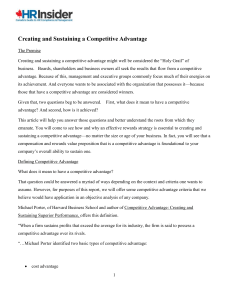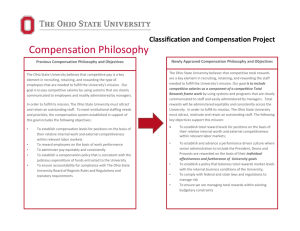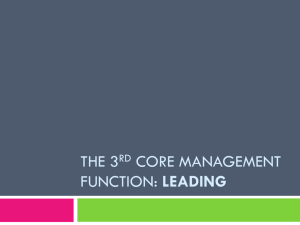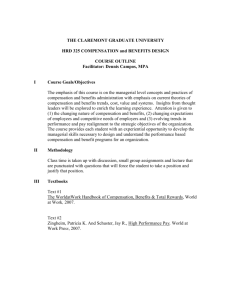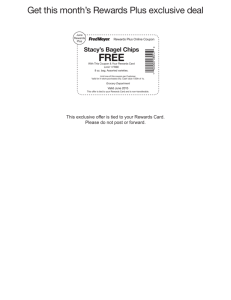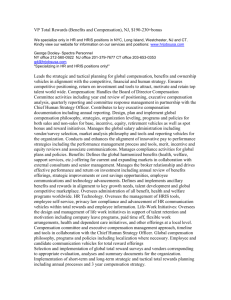Creating and Sustaining a Competitive Advantage
advertisement
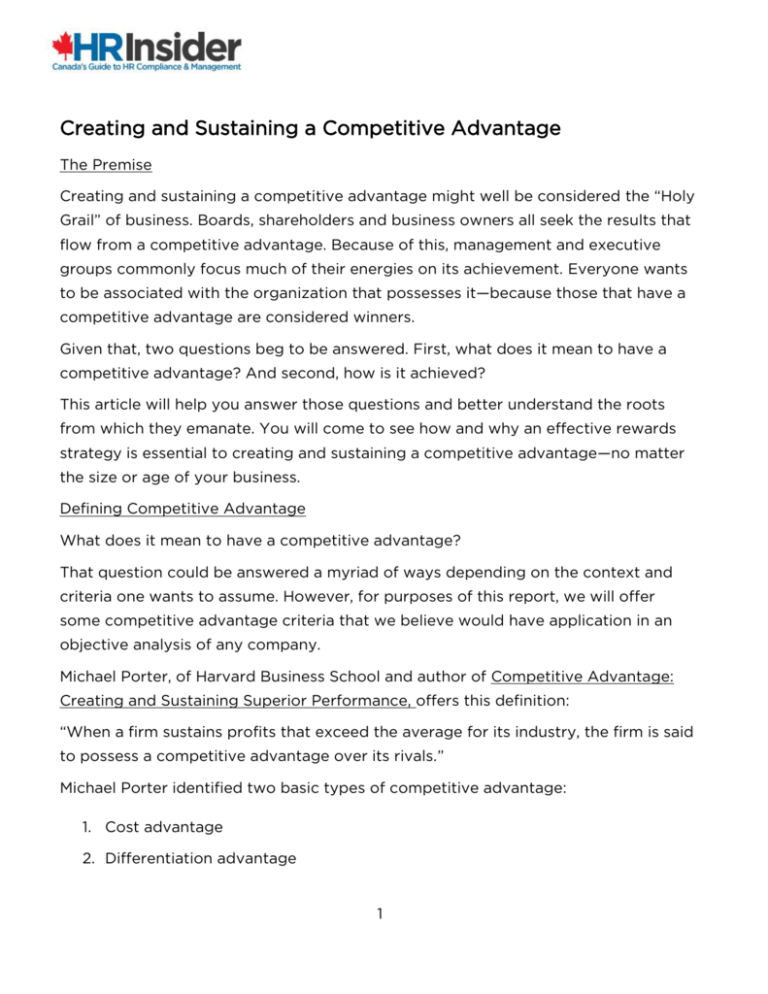
Creating and Sustaining a Competitive Advantage The Premise Creating and sustaining a competitive advantage might well be considered the “Holy Grail” of business. Boards, shareholders and business owners all seek the results that flow from a competitive advantage. Because of this, management and executive groups commonly focus much of their energies on its achievement. Everyone wants to be associated with the organization that possesses it—because those that have a competitive advantage are considered winners. Given that, two questions beg to be answered. First, what does it mean to have a competitive advantage? And second, how is it achieved? This article will help you answer those questions and better understand the roots from which they emanate. You will come to see how and why an effective rewards strategy is essential to creating and sustaining a competitive advantage—no matter the size or age of your business. Defining Competitive Advantage What does it mean to have a competitive advantage? That question could be answered a myriad of ways depending on the context and criteria one wants to assume. However, for purposes of this report, we will offer some competitive advantage criteria that we believe would have application in an objective analysis of any company. Michael Porter, of Harvard Business School and author of Competitive Advantage: Creating and Sustaining Superior Performance, offers this definition: “When a firm sustains profits that exceed the average for its industry, the firm is said to possess a competitive advantage over its rivals.” Michael Porter identified two basic types of competitive advantage: 1. Cost advantage 2. Differentiation advantage 1 “A competitive advantage exists when the firm is able to deliver the same benefits as competitors but at a lower cost (cost advantage), or deliver benefits that exceed those of competing products (differentiation advantage)… A resource‐based view emphasizes that a firm utilizes its resources and capabilities to create a competitive advantage that ultimately results in superior value creation… According to the resource‐ based view, in order to develop a competitive advantage the firm must have resources and capabilities that are superior to those of its competitors. Without this superiority, the competitors simply would replicate what the firm was doing and any advantage would quickly disappear.” (As quoted at: quickmba.com/strategy/competitive‐advantage.com; March 13, 2007, emphasis added) Mr. Porter’s insights regarding the resource‐based view correspond to our experience working with hundreds of companies over the past 30 years. In addition to the measures set forth in his article, HR Insider would add the following characteristics a company must possess if it is to have resources and capabilities that are superior to those of its competitors. They are the qualities a company needs to possess if the cost, differentiation and resource factors that Porter identifies are going to manifest and sustain themselves: 1. It has a clearly defined and compelling vision, purpose and value proposition that resonates both with its consumer audience and its employee base. 2. Its value proposition is supported by a unique product or service that has significant (measurably significant) demand in the marketplace, or... 3. It has a means of creating an experience with a product or service that is distinct and exceptional— and therefore enjoys significant (measurably significant) demand in the marketplace. 4. The demand for the product or service (or experience) is anticipated, by all reasonable measures, to be sustainable for the foreseeable future. 5. It has an infrastructure that will allow it to continue to deliver on its value proposition to the marketplace better and/or more cost effectively (both for the company and for its customer/client) than its competition. 6. It has the ability to attract, retain and properly focus people of exceptional talent to deliver on and sustain the company’s value proposition. 2 (One can argue whether or not this overview of factors is complete for purposes of a sustainable competitive advantage evaluation. However, for our intent it provides sufficient rationale for examining whether or not a company enjoys this position now and how it can get closer to this result if it doesn’t.) The Key: Properly Prepared Soil Despite all of the energy and resources that companies invest in an effort to build a competitive advantage, few can claim the characteristics listed above. Even those that do possess them for a time can’t always sustain them. Why is that? The answer to that question really goes to the heart of how a competitive advantage is ultimately realized. And it’s quite simple really. Our experience and research indicate that companies fail in this effort when they try to “grow” their business out of “unfertilized soil.” In other words, too many businesses try to reap the harvest of product innovation, effective branding, or key acquisitions while planting their seeds in uncultivated ground. As a result, no matter how great their potential, the seeds of competitive advantage remain dormant until and unless the soil is properly prepared. Let us explain. There are two related issues here. The first is making sure the company has the right people in place. The second is making sure those people are focused on the right issues. Let’s restate it here. “It (the company) has the ability to attract, retain and motivate people of exceptional talent to deliver on and sustain the company’s value proposition.” This statement goes to the heart of what Porter described earlier as the need to have resources and capabilities that are superior to your competitors. What resource or capability could any organization have that would be more important than its people? With that in mind, everything related to a competitive advantage “harvest” begins with hiring and keeping the right people—then making sure they are focused on the right performance factors. If you think otherwise, then perhaps you can identify a 3 company that has the wrong people focused on the wrong issues and are somehow sustaining a competitive advantage. It just doesn’t happen. Your people and their distinctive abilities are the soil that must be prepared and cultivated before a competitive advantage harvest can be achieved. This conclusion is born out in real (business) life over and over again. However intuitive this may seem, it is interesting to note how many companies focus on peripheral issues before looking at this foundational starting point in their competitive advantage quest. Two well‐ known authors have noted this fundamental truth. First, Jim Collins in Good to Great explains: “When we began the research project, we expected to find that the first step in taking a company from good to great [another way to frame the concept of competitive advantage] would be to set a new direction, a new vision and strategy for the company, and then to get people committed and aligned behind that new direction. “We found something quite the opposite. “The executives who ignited the transformations from good to great did not first figure out where to drive the bus and then get people to take it there. No, they first got the right people on the bus (and the wrong people off the bus) and then figured out where to drive it. “…The good‐to‐great leaders understood…simple truths. First, if you begin with ‘who,’ rather than ‘what,’ you can more easily adapt to a changing world. If people join the bus primarily because of where it is going, what happens if you get ten miles down the road and you need to change direction?” (Good to Great, Jim Collins, Harper Collins Publishers, Inc. 2001, pgs. 41‐42) Under this premise, one could almost reduce the criteria for competitive advantage to one issue— getting and keeping the right people. If you have the right people, you can carve out whatever strategy is needed for success and know that it will happen. However, a second issue is equally important. Once you have the right people and have developed a compelling vision, purpose and strategy, how do you keep those 4 people productively focused on the roles and expectations that will lead to success? In his book Winning, Jack Welch had this to say in answer to that question: “Hiring good people is hard. Hiring great people is brutally hard. Yet nothing matters more in winning than getting the right people on the field, then guiding them on the right way to succeed and get ahead. “If you want people to live and breathe the vision, ‘show them the money’ when they do, be it with salary, bonus, or significant recognition. To quote a friend of mine, Chuck Ames, the former Chairman and CEO of Reliance Electric, ‘Show me a company’s various compensation plans, and I’ll show you how its people behave.’” (As quoted in Newsweek, April 4, 2005, pgs. 47, 46, emphasis added) So then, are we really saying that having the right people and giving them the right compensation is all that is needed to attain and sustain a competitive advantage? Not exactly. Certainly, there are capital, operations, product, marketing, servicing and performance management issues that have to be addressed. That is understood and no one could reasonably argue otherwise. However, what we are saying is that none of the fruits of a competitive advantage will be realized if this “cultivating the soil” issue isn’t done right. It’s just not possible to reap a harvest when the seeds have not been properly sown. Given the evidence just summarized, one might consider the attainment then of a marketplace competitive advantage as the culminating effect of a series of “bite‐ sized” harvests of competitive advantage being fulfilled. And the first of these must be the creation of a rewards strategy that meets the following standard: 1. Attracts and retains the right people 2. Focuses those people on the right issues—the key performance factors for your company 3. Provides rewards (motivating and attainable incentives) for those individuals to perform at the highest level 4. Generates an appropriate return on the company’s compensation investment; pay is linked to a performance philosophy and standards where incentives are paid out of a greater whole that the organization’s talent helps create 5 The “Total Rewards” Value Proposition A company whose rewards strategy has become a competitive advantage recognizes that compensation is only one of four issues that have to be engineered and managed. The others are worthy of mention. They would include: a compelling future; personal and professional development opportunities and a positive work environment. However, our experience has been that unless you get compensation right, these other elements are hard if not impossible to achieve. As a result, wellengineered compensation plans become a cohesive link within the total rewards strategy that makes up a company’s value proposition for its key talent. Why is this issue so critical? Think about the criteria we outlined in the early part of this article. To achieve a competitive advantage one must have a compelling value proposition that is built around a product, service or experience for which there is significant demand in the marketplace. Further, we have said that value proposition needs to be supported by an infrastructure that can consistently deliver on the brand promise. At the heart of that infrastructure is a superior performance unit or team (or a series of them). And what, or rather who, is at the heart of that team? If it’s a superior group, it is made up of individuals with exclusive, exceptional and often matchless abilities. The key, then, to creating a compensation strategy that will be a competitive advantage is to envision, create and sustain rewards strategies that will draw a compelling link between the following elements in the minds of your key talent: company vision (where), business strategy (how), roles and expectations (who and what), rewards (how much) and employee vision (relevance). This is called creating “line of sight”—and any company that expects to have a competitive advantage must achieve it. Once line of sight is achieved, companies come to recognize that a compelling compensation and rewards strategy doesn’t just enhance competitive advantage, in fact, it becomes the competitive advantage. A Preliminary Conclusion While product innovation, manufacturing systems, marketing strategies et al are still sources of competitive advantage, they are not enough. Nor are they typically the right place to start. If you are seeking a sustainable competitive advantage, and you 6 fail to look at your compensation and rewards systems first, you are trying to bear fruit without sowing your seeds in a prepared field. It just won’t work. Conversely, when a company focuses its energies on bringing in the right people and keeping them properly focused to produce meaningful results over both short and long‐term periods, it is nurturing a certain kind of culture. When done effectively, that culture has a distinctive imprint—because culture is not “copyable.” As a result, it (the culture) becomes the ultimate competitive advantage. Where to Begin At this point, you might be asking the question, “Okay, so where do I start? How do I begin looking at my compensation more strategically and with the proper balance? How do I transform my company’s value proposition for current and prospective employees into a competitive advantage?” The process of effectively engineering a rewards strategy includes four sequential phases, each with a specific purpose for the serious‐minded pursuer of a competitive advantage. We can define these phases as follows: 1. Diagnose — Assess where the company stands currently in providing compensation solutions that effectively reinforce the company vision and strategy. 2. Envision — Develop a game plan and philosophy growing out of the diagnosis that will guide all decisions made about compensation and other rewards programs going forward. 3. Create — Engineer compensation programs that effectively align roles and expectations with your company vision and strategy. 4. Sustain — Implement an ongoing effort to maintain the focus of key talent on the performance factors that will lead to the fulfillment of company goals through a well-orchestrated rewards reinforcement strategy. Let’s look at each of these phases in a little more detail. Diagnose To begin an assessment of where your company stands in the context of this discussion, consider rating your organization on a scale of 1 to 10 relative to the 7 following issues (10 being most descriptive of your organization and 1 being the least): 1. Our management employees achieve the key performance indicators for which they have responsibility. 2. Our current team of management employees is motivated to achieve the growth goals the company has set for the next 3‐5 years. 3. Our organization has an effective means of creating and managing performance incentives for key people. 4. We have established clear compensation standards relative to market pay and best practices, and we follow them. 5. The key employees in our company demonstrate an “ownership mentality.” Your ratings for each of these statements will give you some indication of whether or not your current compensation program is a competitive advantage. There are several other statements that could be assessed as well — but it doesn’t take long for most organizations to determine that there is work to be done in developing a compelling value proposition that will attract, retain and motivate the best people. When engaging clients in this process, we recommend that further diagnosis should include the following: 1. “Line of Sight” Assessment — This is typically achieved through interviews or surveys of owners/shareholders and key employees. This is the process of determining the clarity and consistency of understanding between ownership and employees of the company’s vision and strategy, each person’s roles and expectations and the rewards associated with performance. 2. Market Pay Assessment — This is the process of looking at market pay data for a given company and its industry and then asking, “therefore what?” Determining how and when to use market pay data is a key factor in creating a compensation strategy that is on its way to becoming a competitive advantage. 3. Total Rewards Assessment — Whereas the Market Pay Assessment examines “how much” you’re paying your employees, a Total Rewards Assessments asks “how” you are paying your employees. This process looks at the total rewards allocation currently being offered by an organization and evaluates that allocation in the context of both best practices and the organization’s vision and strategy. It helps identify obvious gaps as well as strengths. 8 These tools might be compared to the various tests a physician performs before determining the appropriate treatment for what ails you. It is the starting point for any organization that hopes to bring about a course correction that will have a lasting effect. Envision The diagnostic steps are essential to envisioning potential strategies and solutions that will create the “line of sight” talked about earlier—the key to having a compensation strategy that is a competitive advantage. In our work with clients, the findings that grow out of that process are summarized in a Compensation GamePlan. This report frames the information derived from the assessments, establishes a preliminary rewards philosophy, provides a series of recommendations and timelines, and conceptualizes the core plan that should be addressed first in creating a more effective strategy. Much like a professional sports team will devise a plan for how it will approach an upcoming game, the Compensation GamePlan defines a course of action the company will take from a compensation perspective to better align the vision and strategy of the company (owners and shareholders) with the roles of its key people. Within this context then, the Envision phase should ultimately define the following: 1. The Strategic Purpose— establish a clear plan purpose tied tightly to core business goals and strategies. 2. The Plan Blueprint—develop preliminary features that can serve as a template for final design provisions and evaluate alternatives that will lead to the selection of optimal plan design specifications. Create An effective Compensation GamePlan establishes the blueprint out of which the plan creation process can then emerge and take shape. Too often, companies attempt to create or re‐engineer a plan without laying the groundwork that the Diagnose and Envision stages address. Consequently, the plans that result are often short‐lived and have minimal impact. However, when the plan design grows out of a clear picture of what you’re trying to accomplish and the outcomes desired, then behavior is changed and performance is improved. 9 We recommend four basic steps: 1. Establishing a Financial Framework—the plan needs to be forecast in a financial model that illustrates the projected impact on both the company and the participants. 2. Defining Plan Provisions—careful attention needs to be paid to articulating specifications and defining an operational plan that will ensure a strategic impact. 3. Writing Plan Documentation—the plan needs to be documented in a way that both satisfies legal requirements and clearly communicates the plan to participants. This will often mean the plan will have both a legal agreement and a summary plan description that needs to be written and delivered. 4. Launching the Plan—ultimately, the plan needs to be introduced to employees in a clear and motivating way so that enthusiasm and interest is secured from the outset. Sustain For many companies, the plan creation stage is the ending point in the development of their pay strategy for key employees. They feel that if they have effectively designed a plan and launched it, they are done. Nothing could be further from the truth—and this conclusion leads many employers to scratch their heads a year or two later—wondering why their plan is not bringing about a better result. The truth is, in many respects the plan creation stage is just the beginning. Now the real work (and opportunity) starts. Once a plan has been effectively and strategically drafted in the context of a well thought out philosophy and game plan, it needs to be sustained. We might liken this to the preparation of a satellite launch. Much work goes into getting the rocket off the ground, but once that’s done everything is for naught if the space ship is not kept in orbit. And so it is with your rewards strategies. Once launched, they need a sustaining effort and operational structure that will ensure reinforcement of the roles and expectations you have for the individuals that are fulfilling those roles. High performing companies consistently get this part of their value proposition right. They effectively manage, communicate and reinforce rewards. 10 We would recommend at least six issues to be addressed in the development of an effective rewards reinforcement strategy. These steps can either be assumed by the employer or can be outsourced to companies such as ours. They are as follows: 1. A Reinforcement Commitment—this is the determination of roles, methodology (initiate internally, seek validation from outside source or delegate to a professional service firm) and timetables for effective plan fulfillment. 2. A “Backstage” GamePlan—which is the process of establishing and operating a system that ensures effective plan administration and operation. 3. A Financial Monitor—which is a mechanism that ensures effective oversight of the budget, accounting, tax, funding and financial statement management issues impacted by the plan. 4. Compliance Management—similar to the financial issue, this step establishes a process for monitoring legal, statutory and regulatory concerns impacting the plan. 5. A Communication Strategy—which provides a means for the reinforcement of the value proposition through effective plan communication and promotion. 6. A “Line of Sight” Review—this is the process of reviewing annually the plan’s performance in the context of The Strategic Purpose (see “Envision” stage above) and making adjustments as needed. In Conclusion As Albert Einstein said, “No problem can be solved from the same level of consciousness that created it.” In like manner, many of those that are pursuing the Holy Grail of a competitive advantage are approaching that goal at a level of thinking that can only perpetuate the status quo or, at best, incremental improvement. A competitive advantage can only grow out of soil that has been prepared by the attraction and retention of the “best” people. The unique talent that a company secures is its first and most important competitive advantage. Individuals applying their abilities in the framework of a distinctive team allow an organization to bear the fruit of a compelling and enduring value proposition— which is the root of a competitive advantage. A rewards strategy that is effectively envisioned, created and sustained provides the nutrients and additives that allow those individuals and teams to bear a fruit that will fuel company success and growth. And as with any 11 worthwhile journey, the search for this Holy Grail promises a fulfilling outcome to all that pursue it—one resulting in a success that can best be called “A Competitive Advantage.” 12

